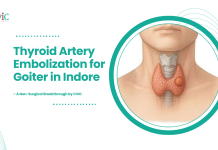Introduction
Gastrointestinal complications can pose significant challenges to a person’s health, affecting digestion, nutrient absorption, and overall well-being. Among these complications, biliary obstruction is a common issue that demands timely and effective intervention. In this comprehensive guide, we will delve into the world of Percutaneous Transhepatic Biliary Drainage (PTBD) and Metallic Stenting, exploring their roles, procedures, and the impact they have on patients’ lives.
Understanding Biliary Obstruction
Before delving into the procedures, it’s crucial to grasp the basics of biliary obstruction. The biliary system comprises the liver, gallbladder, and bile ducts, responsible for producing and transporting bile necessary for digestion. Biliary obstruction can result from various causes, including gallstones, tumors, inflammation, or strictures.
Signs and Symptoms
Recognizing the signs and symptoms of biliary obstruction is crucial for timely intervention. Patients may experience jaundice (yellowing of the skin and eyes), dark urine, pale stools, abdominal pain, and nausea. These symptoms often indicate an underlying issue in the biliary system that requires medical attention.
Diagnostic Tools
To diagnose biliary obstruction, healthcare professionals employ various diagnostic tools, including blood tests, imaging studies (such as ultrasound, CT scans, and MRIs), and endoscopic procedures like ERCP (Endoscopic Retrograde Cholangiopancreatography). Once diagnosed, the choice of intervention depends on the severity and underlying cause of the obstruction.
Percutaneous Transhepatic Biliary Drainage (PTBD)
Procedure Overview
Percutaneous Transhepatic Biliary Drainage (PTBD) is a minimally invasive procedure designed to relieve biliary obstruction. This technique involves creating a passage through the liver to drain bile directly from the bile ducts.
Step-by-Step Procedure
Patient Preparation: Before the procedure, patients are adequately prepared, which may include fasting and discontinuing certain medications.
Imaging Guidance: Under the guidance of imaging techniques like ultrasound or fluoroscopy, a specialized needle is inserted through the skin and into the liver to access the bile duct.
Creation of Tract: A thin, flexible tube (catheter) is threaded through the needle and into the bile duct. A tract is then created by dilating the puncture site to allow for the passage of the catheter.
Placement of Drainage Catheter: The drainage catheter is carefully positioned within the bile duct, allowing the obstructed bile to flow out, relieving the pressure within the biliary system.
Securing the Catheter: The catheter is secured in place, often with the help of sutures or a dressing to prevent displacement.
Post-procedure Monitoring: After the procedure, patients are monitored for any potential complications, and imaging studies may be performed to ensure the effectiveness of the drainage.
Advantages and Considerations
PTBD offers several advantages, including its minimally invasive nature, effectiveness in relieving biliary obstruction, and its applicability when other methods are not viable. However, it’s essential to consider potential complications, such as infection or bleeding, and to weigh the benefits against the risks on a case-by-case basis.
Metallic Stenting in Gastrointestinal Interventions
Understanding Stents
In the realm of gastrointestinal interventions, metallic stents play a pivotal role in managing strictures and obstructions.
Types of Metallic Stents
Biliary Stents: Specifically designed for the biliary system, these stents help keep the bile ducts open, allowing the free flow of bile.
Esophageal Stents: Used to alleviate obstructions in the esophagus, these stents provide a pathway for food and liquids to pass through.
Colonic Stents: Employed in the treatment of colorectal obstructions, these stents facilitate the passage of stool.
Indications for Metallic Stenting
Malignant Obstructions: Metallic stents are frequently used in cases of obstructive cancers, such as pancreatic or biliary tract cancers, to enhance the quality of life for patients.
Benign Strictures: Conditions like chronic pancreatitis or inflammatory bowel disease can lead to strictures that impede the normal flow of fluids.
The Stenting Procedure
Pre-procedural Evaluation: Before the stenting procedure, a thorough evaluation of the patient’s condition is conducted, including imaging studies and a review of medical history.
Selection of Stent Type and Size: Based on the nature and location of the obstruction, the appropriate type and size of the metallic stent are chosen.
Endoscopic Placement: In many cases, metallic stents are placed using endoscopic guidance. The stent is mounted on a delivery system and advanced to the site of the stricture.
Expansion of the Stent: Once in position, the stent is expanded, exerting outward pressure on the stricture or obstruction, creating a widened channel for the passage of fluids or food.
Post-procedural Monitoring: After stent placement, patients are monitored for any adverse reactions or complications. Periodic follow-up may include imaging studies to assess the stent’s integrity.
Advantages and Considerations
Metallic stenting offers several advantages, such as rapid relief of symptoms, improved quality of life, and a reduced need for repeated interventions. However, considerations include the risk of stent migration, infection, and the possibility of stent-related complications.
Comparative Analysis: PTBD vs. Metallic Stenting
While both PTBD and metallic stenting are effective interventions for biliary obstruction, their selection depends on various factors, including the underlying cause of the obstruction, the patient’s overall health, and the anatomical location of the problem.
PTBD Advantages:
Universal Applicability: PTBD can be employed in a wide range of cases, including both benign and malignant obstructions.
Temporary Solution: PTBD is often used as a temporary measure to relieve acute symptoms, and it can be followed by further interventions or surgeries.
Flexibility in Approach: PTBD allows healthcare providers to access the biliary system from different angles, enhancing flexibility in managing complex cases.
PTBD Considerations:
External Drainage: PTBD involves the external drainage of bile, which may necessitate the use of drainage bags and careful management to prevent infection.
Risk of Complications: While PTBD is generally safe, there is a risk of infection, bleeding, or injury to surrounding structures during the procedure.
Metallic Stenting Advantages:
Long-Term Solution: Metallic stents can provide a more prolonged solution, especially in cases of chronic or recurrent obstructions.
Improved Quality of Life: Stents can rapidly alleviate symptoms, enhancing the patient’s quality of life by restoring normal physiological functions.
Metallic Stenting Considerations:
Risk of Migration: There is a risk of stent migration, which may require additional interventions or repositioning.
Limited Applicability: Metallic stenting may not be suitable for all cases, particularly when there are anatomical challenges or the obstruction is not amenable to stent placement.
Patient Perspective and Quality of Life
Both PTBD and metallic stenting aim to improve the quality of life for patients suffering from biliary obstruction. The choice between these interventions often involves a careful consideration of the individual patient’s needs, the nature of the obstruction, and the potential for long-term success.
Patients who undergo PTBD may experience temporary relief of symptoms, allowing for further diagnostic and therapeutic interventions. However, the presence of an external drainage system may impact daily activities, and repeated procedures may be necessary.
On the other hand, metallic stenting offers a more immediate and potentially long-lasting solution. The endoscopic placement of stents can significantly improve the patient’s quality of life by restoring the normal flow of bile or other bodily fluids. However, the success of metallic stenting depends on factors such as proper stent selection, placement, and ongoing monitoring.
Conclusion
In the world of gastro-interventions, Percutaneous Transhepatic Biliary Drainage (PTBD) and Metallic Stenting stand as valuable tools for managing biliary obstruction. These procedures, though distinct in their approaches, share the common goal of alleviating symptoms, improving the quality of life for patients, and providing healthcare providers with effective options for intervention.
As medical technology continues to advance, the field of gastrointestinal interventions evolves, offering hope to those facing the challenges of biliary obstruction.
Our Doctors
Dedicated IR Center for Vascular Problems in Madhya Pradesh
DR. SHAILESH GUPTA
MD, PDCC (INTERVENTIONAL RADIOLOGY) Consultant & Co-Director CVIC (Center Of Vascular & Interventional Care)
DR. ALOK KUMAR UDIYA
MD Radiology, PDCC (Neurointervention Radiology), PDCC ( HPB Intervention Radiology) FINR (Switzerland) & EBIR
Endovascular Surgeon & Consultant Interventional Neuroradiologist at Care CHL Hospital, Indore Co-director CVIC( center for vascular and interventional care)
DR. NISHANT BHARGAVA
Consultant Intervention Radiologist
MD Radiology, PDCC ( Neurointervention Radiology), FINR ( Fellowship in Neurointervention Radiology)
Co-director CVIC(Center for Vascular and Interventional Care)
Contact Details
Phone no.
0731 4675670
+91 9827760073
Facebook
https://www.facebook.com/profile.php?id=100092538633553&mibextid=ZbWKwL
Instagram
https://instagram.com/cvic_center?igshid=ZGUzMzM3NWJiOQ==
Google My business
https://g.co/kgs/DrdV3T
YouTube
https://www.youtube.com/channel/UCP5TH5e4iQZkpDUgnLsgZhw
Pinterest
https://pin.it/5DzpX5Z
Twitter
https://x.com/cviccenter?t=01TclSrLFdu0K2re0Gs96w&s=08
LINKEDIN
https://www.linkedin.com/company/center-of-vascular-interventional-care/
Location –
Read More –
Mechanical Thrombectomy for Acute Stroke – https://cvicvascular.com/mechanical-thrombectomy-for-acute-stroke/
Pre-Operative Embolization of Tumors: A Lifesaving Strategy – https://cvicvascular.com/pre-operative-embolization-of-tumors-a-lifesaving-strategy/
Spinal AVM Embolization – https://cvicvascular.com/spinal-avm-embolization/




